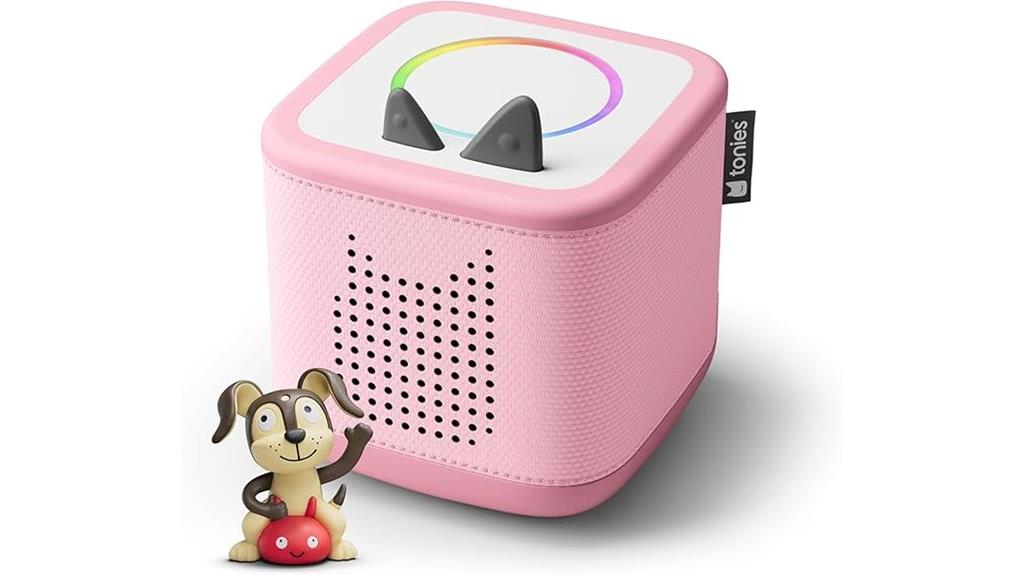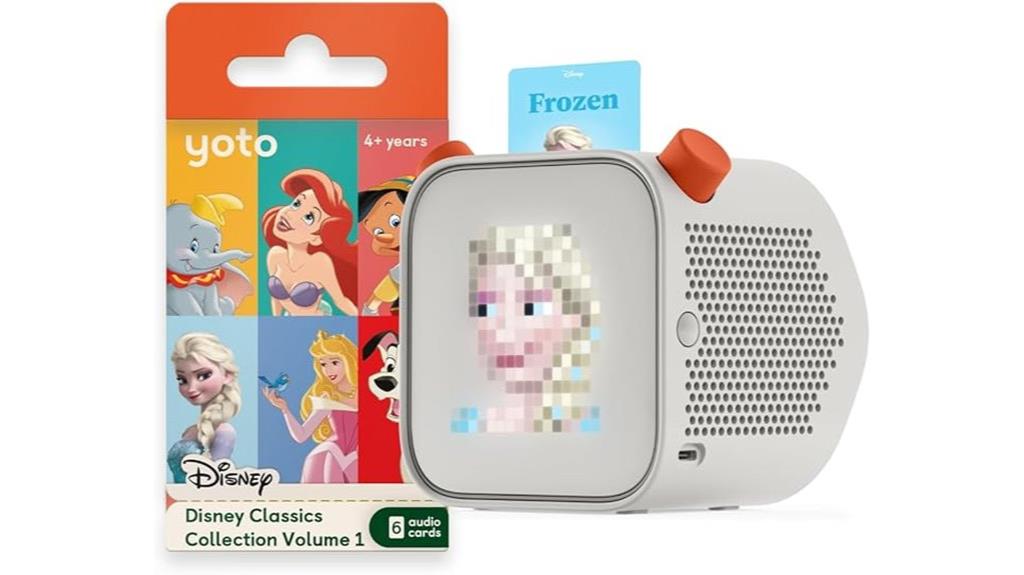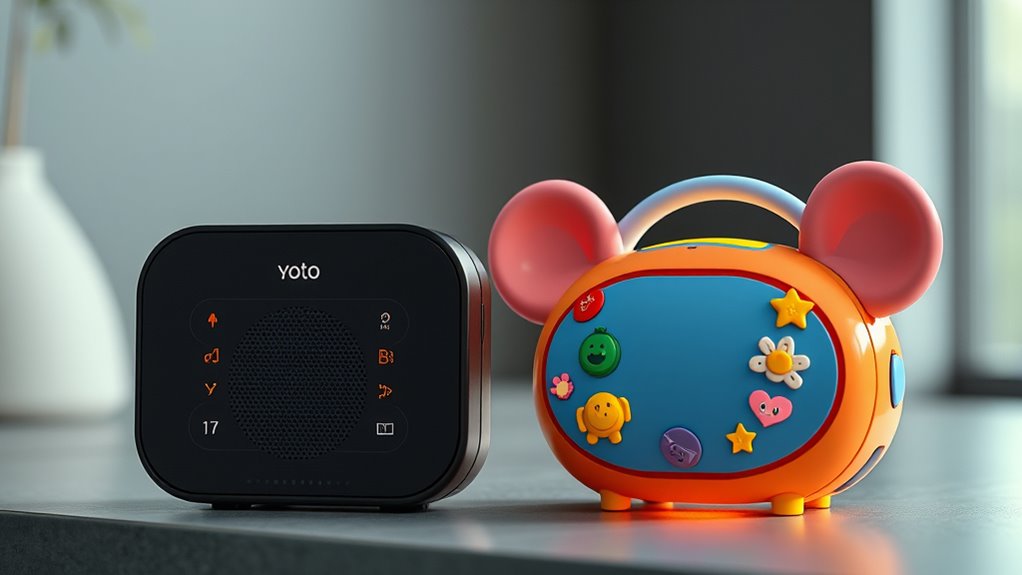In 2025, I find that choosing between the Yoto Player and Toniebox depends on your child’s needs. Yoto offers a huge library of content and customizable options, while Toniebox is praised for its durability and super simple controls. Both are excellent for safe, screen-free listening, but your choice depends on whether your child values variety or rugged design more. Keep exploring — I’ll show you more details to help you decide which is best.
Key Takeaways
- Content library variety and expansion options influence long-term value and user engagement for both devices.
- Durability and child-friendly design ensure safety and longevity during active use.
- Parental controls and safety features provide a secure environment tailored for children’s age-appropriate media.
- Ease of use with simple controls and intuitive interfaces supports independent listening for kids.
- Cost considerations, including initial purchase and ongoing content expenses, affect overall value and suitability for different ages.
Toniebox 2 Audio Player Starter Set for Kids 1

Are you looking for a durable, easy-to-use audio player designed specifically for young children? The Toniebox 2 Starter Set is perfect for ages 1 to 9+, with a sturdy, child-friendly design that encourages independent play. It includes a Cloud Pink Toniebox, a USB-C charging cable, and a Playtime Puppy Tonie, with more options sold separately. The device automatically plays content when Tonies are placed on top, and simple controls like ears and sides make volume and track changes easy. Plus, the Wi-Fi setup guarantees seamless access to a huge library of stories, songs, and games, keeping kids entertained safely and independently.
Best For: parents seeking a durable, easy-to-use, screen-free audio player that fosters independent play and safe entertainment for children aged 1 to 9+.
Pros:
- Child-friendly and intuitive design suitable for young children
- Extensive library of stories, songs, and games with new content added regularly
- Parental controls via the Tonies app for safe, manageable playtime
Cons:
- Wi-Fi setup required for initial content access, which may be challenging for some users
- Additional Tonies and accessories are sold separately, potentially increasing overall cost
- Limited to specific Tonies content, which may restrict variety compared to other media options
Yoto Player (3rd Gen.) + Disney Classics Bundle – Kids Bluetooth Audio Speaker

The Yoto Player (3rd Gen.) + Disney Classics Bundle is an excellent choice for parents seeking a screen-free, safe audio device that combines engaging content with easy usability. It offers a simple setup—just insert a card to play, remove to stop—and features large dials for quick adjustments. The bundle includes six Disney story cards with beloved characters, plus access to over 1,000 other cards like stories, music, and podcasts. Designed with safety in mind, it contains no cameras or ads and includes features like a nightlight and alarm clock. Its portable Bluetooth capability and growth options make it a versatile, kid-friendly device for ongoing entertainment.
Best For: parents and caregivers seeking a safe, screen-free, and versatile audio device for children aged 3-12+ that offers engaging stories, music, and educational content.
Pros:
- Easy to set up and operate with simple card insertion and large dials for adjustments.
- Kid-friendly features include a nightlight, alarm clock, and parental controls, with no cameras or ads.
- Supports a wide variety of content, including over 1,000 cards, personalized Make Your Own options, and Bluetooth connectivity.
Cons:
- Limited screen-based interactivity may not appeal to older children seeking more visual content.
- Content availability depends on purchasing or subscribing to additional cards and materials.
- Some users may find the device’s physical controls less intuitive than app-based controls for advanced functions.
Toniebox 2 Audio Player Starter Set for Kids 1

For parents seeking a durable, kid-friendly audio device that encourages independent play, the Toniebox 2 Starter Set stands out. It features intuitive controls that help children explore stories, songs, and games from their favorite characters, building confidence and independence. Designed for ages 1–9+, it supports hundreds of Tonies and Tonieplay games, with new content added monthly. The device includes smart bedtime and wake-up features, like Sleep Timer with Light and Sunrise Alarm, promoting healthy routines. Its screen-free design and parental app guarantee safe, monitored play. With a sturdy build and simple operation, it’s perfect for young kids to enjoy on their own.
Best For: parents seeking a durable, screen-free, and easy-to-use audio device that encourages independent play and confidence-building in children aged 1–9+.
Pros:
- Kid-friendly, intuitive controls designed for easy operation by young children
- No screens or ads, ensuring safe and independent play
- Supports hundreds of Tonies and Tonieplay games with new content added monthly
Cons:
- Wi-Fi required for initial setup and content updates
- Power adapters and additional Tonies sold separately, which may increase overall cost
- Optional Tonieplay controller is sold separately and not included in the starter set
Factors to Consider When Choosing Yoto Player Vs Toniebox Review

When choosing between the Yoto Player and Toniebox, I consider factors like content library variety, device durability, and parental controls to guarantee the best fit for my child. Ease of use and price also play a big role in my decision, helping me find a device that offers good value. By weighing these points, I can select the option that best balances entertainment, safety, and affordability.
Content Library Variety
Choosing between the Yoto Player and Toniebox often hinges on the variety of content they offer. I find that Yoto’s library boasts over 1,000 cards, covering stories, music, podcasts, and educational content, giving kids a broad mix of media. It also includes customizable “Make Your Own” cards, so children can create personalized stories—adding a unique touch. In contrast, the Toniebox features hundreds of character-themed Tonies, with new ones released monthly, expanding options for stories, songs, and games. While both devices support growing libraries, Yoto’s flexibility with diverse content types and personalized options makes it stand out. If your child prefers a wide range of media and customization, Yoto’s library is more versatile, but Toniebox offers a charming, character-driven collection that’s equally engaging.
Device Durability
Since active play and frequent handling are common with young children, durability is a crucial factor to contemplate. Both the Yoto Player and Toniebox are built with child-friendly, impact-resistant materials. The Toniebox’s soft, shock-absorbent exterior helps it withstand drops and bumps, reducing damage during rough play. Meanwhile, the Yoto Player features a sturdy plastic casing with reinforced edges, protecting its internal components from accidental impacts. Additionally, the controls on both devices are designed to resist wear and tear, ensuring they last through years of use. Choosing a device with high-quality, impact-resistant construction is essential for active children’s environments. Overall, both options are well-made to handle the rigors of everyday handling, but considering their durability can extend their lifespan considerably.
Parental Controls
Durability guarantees that devices can stand up to active play, but keeping children safe while they explore media is equally important. Parental controls play a crucial role in ensuring safe, age-appropriate content access and monitoring usage. Many devices offer companion apps that let parents manage content and set time limits remotely, giving peace of mind. Built-in filters and curated content help reduce exposure to unsuitable material, making it easier to guide children’s media experiences. Some platforms allow parents to customize or restrict features like internet access or downloads, adding an extra layer of safety. Additionally, features like sleep timers, activity reports, and notifications can promote healthy media habits. Overall, parental controls are essential for creating a safe, controlled environment that encourages responsible media consumption.
Ease of Use
When evaluating ease of use, both the Yoto Player and Toniebox prioritize simple controls that young children can navigate independently. The Yoto uses large dials and card insertion, making it straightforward for kids to operate without much help. Its setup is simple—just insert a card to start listening—and the control app allows parents to manage content remotely. The Toniebox features touch-sensitive ears and sides for navigation, which are intuitive for children, with volume adjustment through the ears and track changes via side taps. Both devices are designed for minimal steps, ensuring children aged 1–12+ can access content easily. Overall, their physical controls are user-friendly, and their intuitive design makes it easy for children to enjoy listening independently.
Price and Value
Choosing between the Yoto Player and Toniebox depends heavily on your budget and how much value you prioritize. Yoto Players usually come with a higher upfront cost because of their multifunctional features and larger content library. In contrast, Toniebox sets often include a starter Tonie and accessories, offering good value right out of the box. However, the cost of additional content, like Tonies or cards, can add up over time for both devices. Yoto provides a wide range of content cards, including educational and themed bundles, which can be more cost-effective for varied interests. When deciding, consider not just the initial price but also durability, content variety, and ongoing content expenses. This will help you determine which system offers better long-term value for your family.
Age Appropriateness
Selecting the right device for your child’s age is essential to guarantee safe and appropriate use. I recommend checking that the device’s age recommendation matches your child’s current age, ensuring it’s suitable and safe. For younger children, look for simple controls and durable designs that can withstand rough handling. For older kids, choose devices with more advanced features and customization options. It’s also important to verify that the content library offers age-appropriate stories, songs, and activities that match your child’s maturity level. Additionally, consider parental controls that help tailor content and safety settings for different ages. Finally, confirm the device’s physical design and durability suit your child’s age to prevent damage or safety hazards. This careful consideration promotes safe, enjoyable, and developmentally suitable audio experiences.
Frequently Asked Questions
How Durable Are the Yoto Player and Toniebox for Rough Handling?
Both the Yoto Player and Toniebox are pretty durable for rough handling, which is great if your kid is active. I’ve found that the Toniebox’s soft, rubberized exterior helps it withstand drops, while the Yoto Player’s sturdy build also holds up well. Still, I recommend supervising playtime and using protective covers to keep them in top shape longer. They’re designed to handle everyday adventures, but a little extra care never hurts!
Which Audio Player Offers Better Parental Controls and Monitoring?
I find that the Toniebox offers better parental controls and monitoring. Its app allows me to set time limits, manage content, and track usage easily. Yoto Player also has good controls, but I prefer the simplicity and detailed options of the Toniebox’s app. It gives me peace of mind knowing I can supervise my child’s listening habits effectively without hassle.
Are There Any Subscription Fees Associated With Either Device?
There are subscription fees for both devices. Yoto offers a subscription for their premium content, which grants a wide library of stories and music, but you can still access some free content without a subscription. Toniebox charges for their Tonies figures, which contain the content, but there’s no ongoing subscription fee. So, while both have costs, Yoto’s subscription is more for ongoing access, and Toniebox’s costs are tied to purchasing figures.
How Do the Audio Quality and Volume Levels Compare?
The audio quality on both devices is quite good, but I find the Yoto Player offers a slightly richer sound with clearer vocals, especially at higher volumes. The Toniebox’s volume can get louder, which is great for noisy environments, but sometimes the sound feels a bit more compressed. Overall, I’d say Yoto provides a more balanced listening experience, while Toniebox is more volume-flexible for different settings.
Can Both Devices Support Multiple User Profiles Simultaneously?
Both devices don’t support multiple user profiles simultaneously. I’ve found that each device is designed for individual use, making it tricky to switch between different users easily. If you’re looking for a shared device for multiple kids, this might be a limitation. I recommend setting up separate profiles or accounts if possible, but for real multi-user support, neither the Yoto Player nor the Toniebox currently offers that feature.
Conclusion
Just like Odysseus choosing his path, selecting between the Yoto Player and Toniebox ultimately depends on what adventure you want your child to set out on. Both are fantastic, but if I had to choose, I’d lean toward the one that best fits your child’s curiosity and your family’s style. After all, in the world of audio players, the real victory is inspiring endless stories and imagination—making every day a new voyage.










